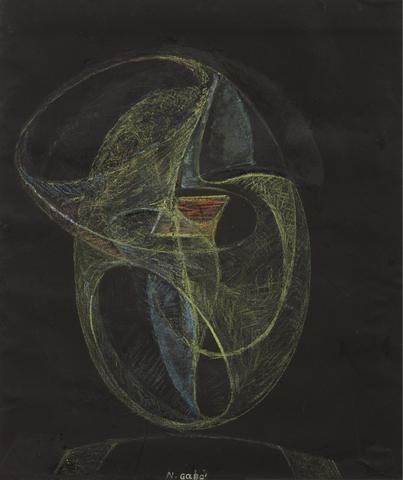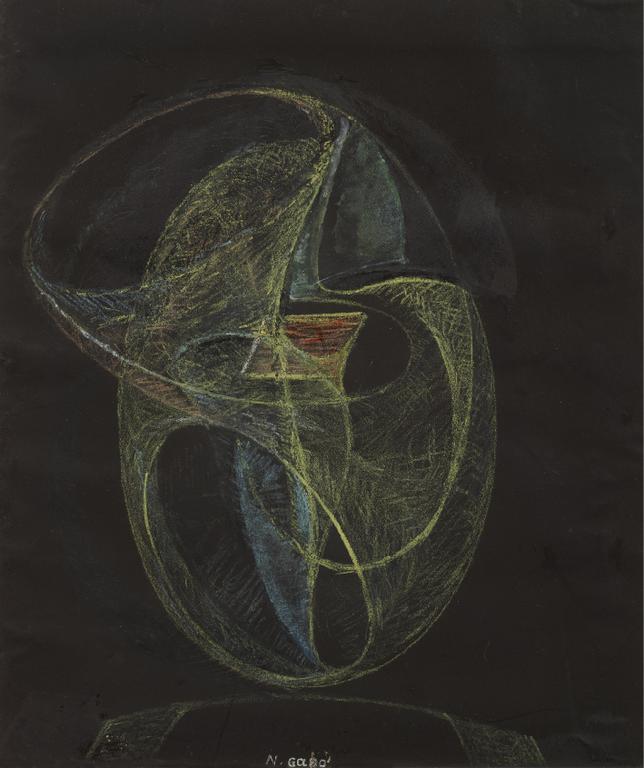
Dessin pour une construction dans l’espace
Naum Gabo (1890 Briansk - 1977 Waterbury)
1935
Huile, aquarelle et crayons de couleur ; 23,7 x 18,7 cm
Provenance :
succession Naum Gabo ; Paris, Galerie de France ; Washington, collection Harry Grubert (en 2009) ; New York, Christie's, 12 novembre 2018 ; Paris, collection Le Polyptyque ; Paris, collection privée.
Exposition :
Naum Gabo (Paris, Galerie de France, 1989-1990, n°22).
Bibliographie :
Herbert Read, Leslie Martin, Gabo: constructions, sculpture, paintings, drawings, engravings, Londres, Lund Humphries, 1957, pl. 113 (reproduit).
Rudolf Wittkower conclut son ouvrage fondamental Qu’est-ce que la sculpture en citant le Manifeste réaliste de 1920, texte fondateur du constructivisme, rédigé par Naum Gabo et son frère Anton Pevsner : « Nous renions le volume en tant que forme plastique de l’espace (...). Nous renions, dans la sculpture, la masse en tant qu’élément sculptural ». Il y voit l’acte de naissance de la sculpture moderne, si différente de ce qui précède qu’elle lui semble « hors sujet », hors en tout cas du sujet de son ouvrage.
Dit autrement, Rodin est plus proche de Michel-Ange, et même de la statuaire préhistorique, que de Gabo. C’est dire la tension vers le but idéalisé, le courage qu’il fallut à ce dernier (et que célèbre le grand critique d’art anglais Herbert Read, qui le comparait à l’abbé Suger « inventant » le gothique) pour imposer sa vision.
En 1935, année charnière de la carrière artistique de Gabo, ce courage faillit lui manquer. Exilé de l’Union Soviétique en 1922, puis d’Allemagne en 1933, il s’installe à Paris trois ans. Fin mai 1935, il fait une tentative de suicide. En juillet, il passe trois semaines à Londres et, en contact avec l’art, parallèle au sien, d’Henry Moore et de Barbara Hepworth, retrouve sa voie. Il repartira pour l’Angleterre en 1936, puis les Etats-Unis de 1946 à sa mort en 1977. Dès 1935 d’ailleurs, quelques-unes de ses œuvres sont exposées au musée de Hartford, Connecticut, le plus audacieux des musées américains dans l’entre-deux-guerres, puis en 1936 au MoMA.
C’est dans ce contexte qu’a été créé ce dessin d’une force magique, qui résume parfaitement son art moins linéaire, angulaire, qu’au début du constructivisme, plus en flux et en courbes, qui sera la marque de Gabo jusqu’à la fin – et dont on peut se demander s’il n’a pas influencé Bacon.
Son dernier propriétaire, Harry Grubert, était un économiste et haut fonctionnaire du Trésor américain, reconnu mondialement comme « le » spécialiste de la fiscalité internationale, y compris le sujet aujourd’hui crucial de la taxation des multinationales. La sobre complexité de ce dessin devait l’enchanter...
